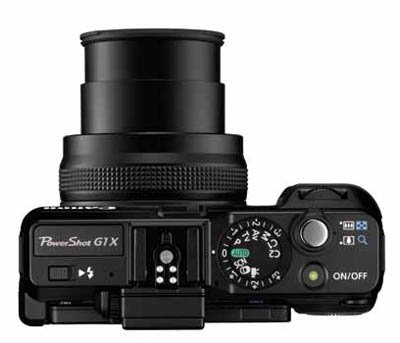articles/Cameras/canong1x-page2
Canon G1X - part 2 of 1 2 3 4 5
Published 01/02/2012

Visually, the most obvious difference is the 15 to 60mm lens. At f2.8-5.8, the need to provide for the larger field area of the chip has increased the size quite a lot, and the optical design has employed a longer extension also. With an equivalent range of 28mm to 112mm it is the lens that moves the camera from being pocketable to needing a bag - sorry, you can't have it all ways!
On test
The unit arrived ahead of any manuals or instructions and so we were left to find our own way around. With the exception of one or two intriguingsounding features, such as 'wink control' we were able to get things up and running reasonably intuitively, although we were limited to shooting JPEGs in the absence of ACR RAW handlers (coming very soon!).
Initial fumbling involved auto bracketing being left on but once we had settled things down we got accurate exposures in both domestic room lighting and a viewing booth, but had to wait for the rain to cease before we got outside. Daylight shooting was carried out at 400 ISO, using auto white balance. An exposure was made of the GretagMacbeth SG chart at 1/125 f5.8 and a focal length of 112mm. The depth of field is quite narrow at this focal length and this offers plenty of creative scope. A thorough reading of the manual will pay dividends for a new user; we found it relatively easy to upset the chosen values, a flaw that has been retained since the G9; this is something that the casual user needs to guard against - sophistication comes at the price of complexity and once you drift off setting you need to understand the menus to get back on track.
Colour testing
In the absence of ACR for RAW files, for the moment, the JPEG files were routed through the ACR so we could measure the exposure accuracy and performance of the auto white balance. The day was very heavily overcast but at least that gave a very controllable contrast range. The image for the SG Chart was 0.45 stops over-exposed. The white balance was just a little warm, some would say more pleasing. The values on 50% grey obtained were as follows:
Out of the camera, then, the image was just a little warm so the 'ACR Balanced' image was fully analysed using the Rags Gardner methodology.
This reported an average error of just 3.24?E00 across all patches, a very good result indeed. The neutrals were more accurate (1.96?E00), the colours a little higher (4.18?E00). The worst colour was a high-gamut orange, at 9.1?E00. The average skin tone error was gratifyingly low at 2.48?E00.
As the composite image (right) shows, this was good shooting all round and the fact that this is a compact camera requires no compromises at all in regard to colour rendering - it will stand alongside the best DSLRs.
Please Note:
There is more than one page for this Article.
You are currently on page 2
1st Published 01/02/2012
last update 21/07/2022 08:46:23
More Cameras Articles
There are 32 days to get ready for The Society of Photographers Convention and Trade Show at The Novotel London West, Hammersmith ...
which starts on Wednesday 14th January 2026










